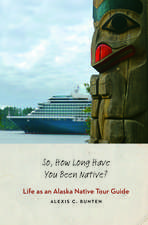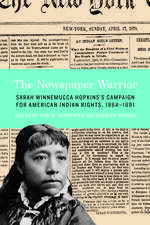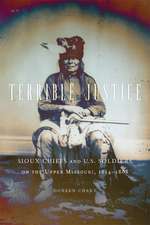The Borderland of Fear: Vincennes, Prophetstown, and the Invasion of the Miami Homeland: Borderlands and Transcultural Studies
Autor Patrick Bottigeren Limba Engleză Hardback – 31 oct 2016
Published through the Early American Places initiative, supported by the Andrew W. Mellon Foundation.
The Ohio River Valley was a place of violence in the nineteenth century, something witnessed on multiple stages ranging from local conflicts between indigenous and Euro-American communities to the Battle of Tippecanoe and the War of 1812. To describe these events as simply the result of American expansion versus Indigenous nativism disregards the complexities of the people and their motivations. Patrick Bottiger explores the diversity between and among the communities that were the source of this violence.
As new settlers invaded their land, the Shawnee brothers Tenskwatawa and Tecumseh pushed for a unified Indigenous front. However, the multiethnic Miamis, Kickapoos, Potawatomis, and Delawares, who also lived in the region, favored local interests over a single tribal entity. The Miami-French trade and political network was extensive, and the Miamis staunchly defended their hegemony in the region from challenges by other Native groups. Additionally, William Henry Harrison, governor of the Indiana Territory, lobbied for the introduction of slavery in the territory. In its own turn, this move sparked heated arguments in newspapers and on the street. Harrisonians deflected criticism by blaming tensions on indigenous groups and then claiming that antislavery settlers were Indian allies.
Bottiger demonstrates that violence, rather than being imposed on the region’s inhabitants by outside forces, instead stemmed from the factionalism that was already present. The Borderland of Fear explores how these conflicts were not between nations and races but rather between cultures and factions.
The Ohio River Valley was a place of violence in the nineteenth century, something witnessed on multiple stages ranging from local conflicts between indigenous and Euro-American communities to the Battle of Tippecanoe and the War of 1812. To describe these events as simply the result of American expansion versus Indigenous nativism disregards the complexities of the people and their motivations. Patrick Bottiger explores the diversity between and among the communities that were the source of this violence.
As new settlers invaded their land, the Shawnee brothers Tenskwatawa and Tecumseh pushed for a unified Indigenous front. However, the multiethnic Miamis, Kickapoos, Potawatomis, and Delawares, who also lived in the region, favored local interests over a single tribal entity. The Miami-French trade and political network was extensive, and the Miamis staunchly defended their hegemony in the region from challenges by other Native groups. Additionally, William Henry Harrison, governor of the Indiana Territory, lobbied for the introduction of slavery in the territory. In its own turn, this move sparked heated arguments in newspapers and on the street. Harrisonians deflected criticism by blaming tensions on indigenous groups and then claiming that antislavery settlers were Indian allies.
Bottiger demonstrates that violence, rather than being imposed on the region’s inhabitants by outside forces, instead stemmed from the factionalism that was already present. The Borderland of Fear explores how these conflicts were not between nations and races but rather between cultures and factions.
Din seria Borderlands and Transcultural Studies
-
 Preț: 217.31 lei
Preț: 217.31 lei -
 Preț: 265.74 lei
Preț: 265.74 lei -
 Preț: 159.22 lei
Preț: 159.22 lei -
 Preț: 159.32 lei
Preț: 159.32 lei -
 Preț: 202.82 lei
Preț: 202.82 lei -
 Preț: 217.47 lei
Preț: 217.47 lei -
 Preț: 332.94 lei
Preț: 332.94 lei -
 Preț: 334.30 lei
Preț: 334.30 lei -
 Preț: 426.41 lei
Preț: 426.41 lei -
 Preț: 428.14 lei
Preț: 428.14 lei -
 Preț: 429.51 lei
Preț: 429.51 lei -
 Preț: 219.64 lei
Preț: 219.64 lei -
 Preț: 464.44 lei
Preț: 464.44 lei -
 Preț: 464.99 lei
Preț: 464.99 lei -
 Preț: 429.89 lei
Preț: 429.89 lei -
 Preț: 259.16 lei
Preț: 259.16 lei -
 Preț: 459.98 lei
Preț: 459.98 lei - 15%
 Preț: 452.68 lei
Preț: 452.68 lei -
 Preț: 300.32 lei
Preț: 300.32 lei -
 Preț: 512.19 lei
Preț: 512.19 lei -
 Preț: 214.80 lei
Preț: 214.80 lei -
 Preț: 508.71 lei
Preț: 508.71 lei -
 Preț: 497.83 lei
Preț: 497.83 lei -
 Preț: 458.45 lei
Preț: 458.45 lei
Preț: 360.59 lei
Nou
Puncte Express: 541
Preț estimativ în valută:
68.100€ • 71.90$ • 57.13£
68.100€ • 71.90$ • 57.13£
Carte tipărită la comandă
Livrare economică 03-17 aprilie
Preluare comenzi: 021 569.72.76
Specificații
ISBN-13: 9780803254848
ISBN-10: 0803254849
Pagini: 270
Ilustrații: 3 figures, 3 maps, 2 tables, index
Dimensiuni: 152 x 229 x 15 mm
Greutate: 0.55 kg
Editura: Nebraska
Colecția University of Nebraska Press
Seria Borderlands and Transcultural Studies
Locul publicării:United States
ISBN-10: 0803254849
Pagini: 270
Ilustrații: 3 figures, 3 maps, 2 tables, index
Dimensiuni: 152 x 229 x 15 mm
Greutate: 0.55 kg
Editura: Nebraska
Colecția University of Nebraska Press
Seria Borderlands and Transcultural Studies
Locul publicării:United States
Notă biografică
Patrick Bottiger is an assistant professor of history at Kenyon College.
Cuprins
List of Illustrations
Preface
Introduction
1. Facing East from Miami Country
2. The National Trinity
3. Prophetstown for Their Own Purposes
4. Vincennes, the Politics of Slavery, and the Indian “Threat”
5. The Battles of Tippecanoe
Conclusion
Notes
Bibliography
Index
Recenzii
"Bottiger has produced a deeply researched and careful volume, one that represents the best job yet of examining the sources for Tippecanoe."—American Historical Review
"This book is a welcome addition to the historiography and contributes a valuable analysis to what some might see as familiar territory."—John P. Bowes, Journal of American History
"The Borderland of Fear offers a well-written, thought-provoking meditation on the complexity of Indian-White relations on the early frontier."—Robert M. Owens, Tribal College Journal of American Indian Higher Education
“Much of what we know about Prophetstown, Patrick Bottiger tells us in this provocative and fascinating new book, is a lie. But lies reveal as well as conceal, and in his hands the world of the Miami borderlands, which the lies both divulge and helped create, is far more compelling than the clashing Indian and American nationalisms that the older stories tell about Tippecanoe.”—Richard White, Margaret Byrne Professor of American History at Stanford University and past president of the Organization of American Historians




















